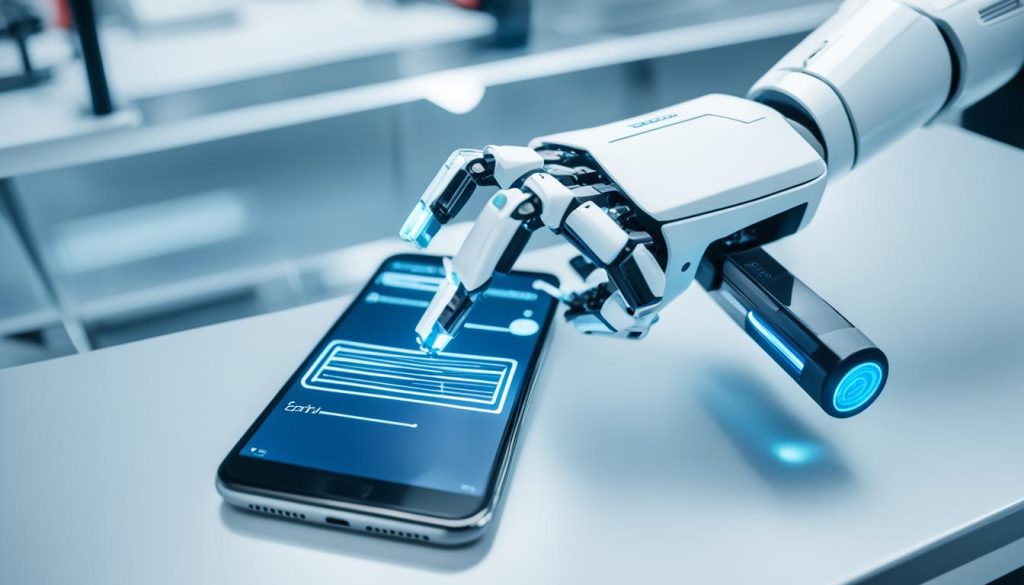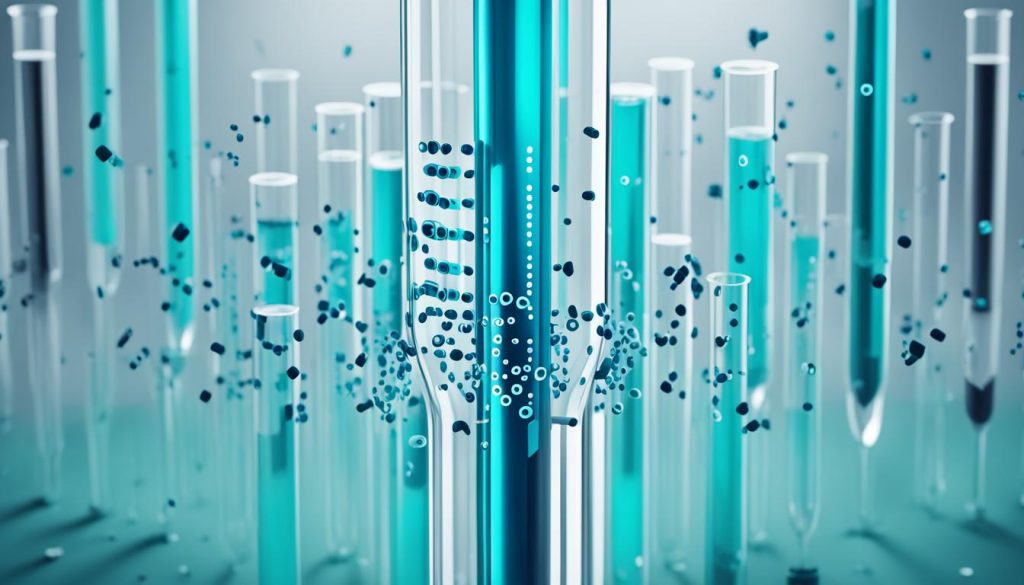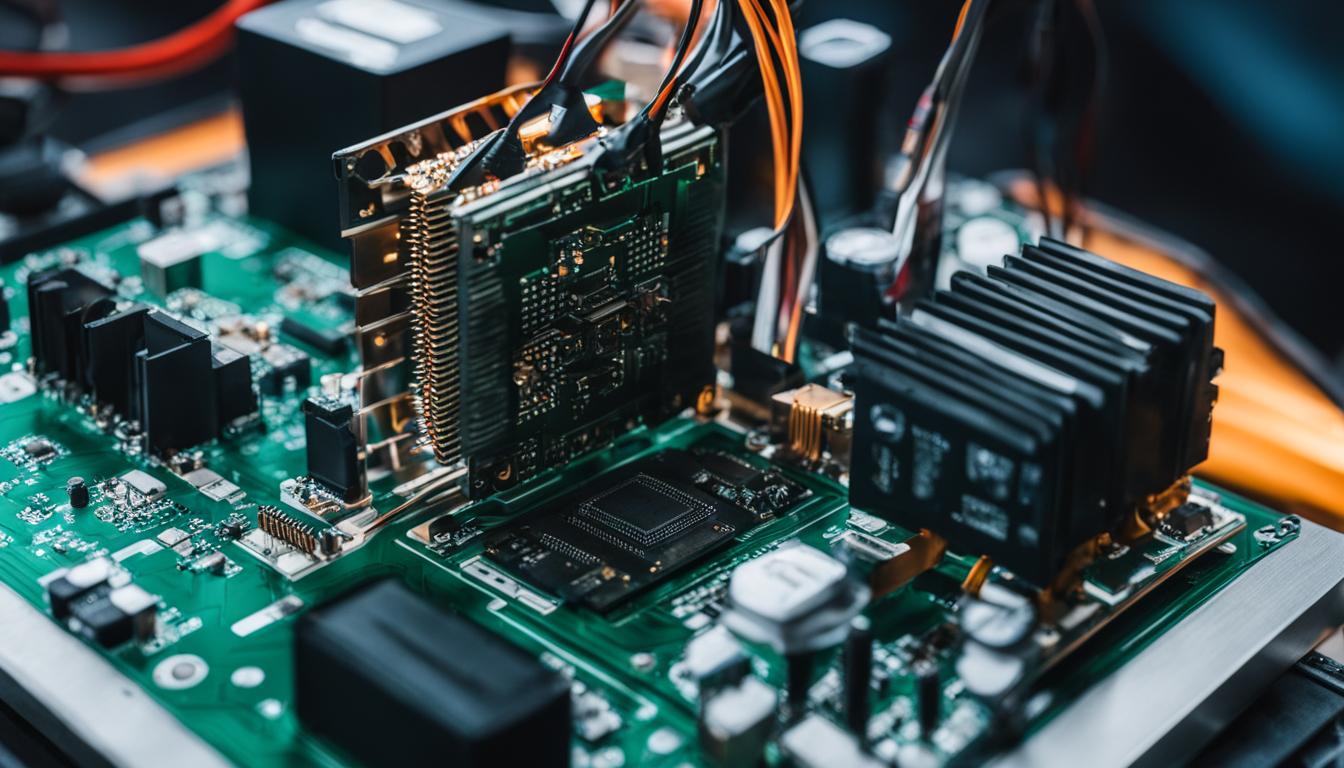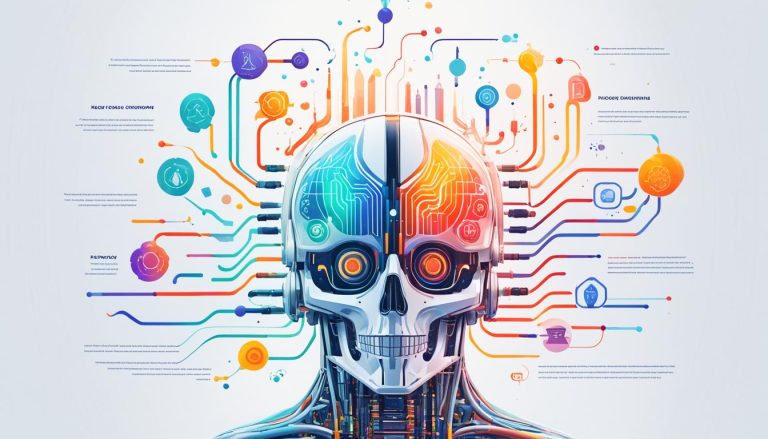AI-driven software testing has revolutionized the software development landscape, improving software quality and accelerating time-to-market for AI systems. The complexity of AI hardware necessitates robust testing protocols to ensure reliable performance and minimize risks.
Testing AI hardware involves comprehensive evaluation of its components, algorithms, and performance capabilities. By automating repetitive tasks and executing test cases at a remarkable speed, AI-driven testing protocols enhance test coverage and efficiency. These protocols can detect defects, vulnerabilities, and performance issues that may be challenging for manual testing alone.
In addition to identifying technical issues, AI-driven testing can evaluate subjective attributes such as usability and trustworthiness. This comprehensive approach ensures that AI systems not only function correctly but also deliver an exceptional user experience.
Key Takeaways:
- AI-driven testing protocols improve software quality and reduce time-to-market for AI hardware.
- Comprehensive evaluation of AI hardware components, algorithms, and performance ensures reliable performance.
- Automated testing protocols enhance test coverage, efficiency, and speed.
- AI-driven testing identifies defects, vulnerabilities, and subjective attributes like usability and trustworthiness.
- Reliable AI systems require robust testing protocols to mitigate risks and inspire confidence.
The Benefits of AI-Driven Software Testing
AI-driven software testing plays a pivotal role in enhancing software quality, ensuring reliable system performance, and meeting end-user expectations. By leveraging the power of artificial intelligence, businesses can streamline their testing processes and achieve comprehensive test coverage while maintaining optimal test speed.
One of the key advantages of AI-driven software testing is its ability to analyze vast amounts of data and identify patterns. Through this analysis, AI can effectively detect defects and vulnerabilities, uncovering hidden issues that may have been missed by manual testing alone.
Moreover, AI-driven software testing automates repetitive tasks, eliminating the need for manual execution and reducing human error. This automation not only saves time but also leads to more comprehensive test coverage, allowing businesses to identify and address potential issues across various test cases and scenarios.
Another significant benefit of AI-driven testing is its impact on test speed. AI-powered tools can execute test cases at an accelerated pace, significantly reducing the time-to-market for software releases. By expediting the testing process, businesses can ensure faster delivery of bug-free code, gaining a competitive edge in the digital market.
“AI-driven software testing significantly enhances software quality, test coverage, and test speed, allowing businesses to meet end-user expectations and stay competitive in the rapidly evolving digital landscape.” – John Watson, CEO of Tech Solutions
In summary, AI-driven software testing provides multiple advantages for businesses seeking to improve their software quality, test coverage, and test speed. By harnessing the power of AI, organizations can analyze data, detect defects, and automate repetitive tasks, resulting in higher-quality software with optimized test coverage. The faster test execution enabled by AI-driven testing ensures efficient time-to-market, allowing businesses to stay ahead in the fast-paced digital market.
The Benefits of AI-Driven Software Testing
The table below presents a comparison of traditional testing methods versus AI-driven software testing:
| Traditional Testing Methods | AI-Driven Software Testing |
|---|---|
| Limited test coverage due to manual creation of test cases | Comprehensive test coverage through automated test case creation |
| Slower test execution, leading to longer time-to-market | Faster test execution, reducing time-to-market |
| Potential for human error during the manual testing process | Elimination of human error through automated testing |
| Risk of missing defects and vulnerabilities | Effective detection of defects and vulnerabilities through AI analysis |
AI’s Role in UI Design Testing
When it comes to testing user interfaces (UI), AI plays a significant role in delivering high-quality and user-friendly experiences. AI has the capability to test not only UI components but also services and lower-level elements that form a cohesive interface. This ensures that all aspects of the UI are thoroughly evaluated, leading to improved usability, accessibility, and trustworthiness.
Traditionally, attributes like usability and trustworthiness were considered subjective in the testing process. However, with AI-powered tools, these attributes can be objectively measured and analyzed. By leveraging historical testing data, user behaviors, and system interactions, AI tools provide valuable insights that drive effective exploratory testing strategies.
Continuous improvement is another advantage of AI-augmented testing. By learning from collected data, AI algorithms can refine testing outcomes over time, adapting to changes in user preferences and evolving UI design trends. This iterative process enhances the software’s usability, accessibility, and trustworthiness, ultimately improving the overall user experience.
One of the challenges in UI testing is the maintenance of test scripts caused by frequent UI design changes. However, AI tackles this problem by enabling efficient functional UI testing with minimal script maintenance. AI algorithms adapt to UI design changes automatically, allowing QA professionals to focus on more critical aspects of the testing process without worrying about script updates.
Benefits of AI in UI Design Testing
- Objectively evaluates usability, accessibility, and trustworthiness
- Provides valuable insights based on historical testing data
- Enables continuous improvement through learning from collected data
- Streamlines functional UI testing with minimal script maintenance
AI’s role in UI design testing goes beyond traditional approaches. It brings objectivity to subjective attributes, empowers exploratory testing strategies, and reduces the burden of maintaining test scripts in dynamic UI environments.
With AI’s involvement in UI design testing, businesses can ensure that their interfaces are user-friendly, accessible to all, and inspire trust among their users. This ultimately results in enhanced user satisfaction, improved brand reputation, and increased customer loyalty.

| Benefit | Description |
|---|---|
| Enhanced Usability | AI evaluates UI elements to ensure a smooth and intuitive user experience. |
| Improved Accessibility | AI helps identify potential barriers and ensures that the UI is accessible to everyone. |
| Trustworthy Design | AI assesses the UI’s trustworthiness, establishing credibility with users. |
As AI continues to advance, its role in UI design testing will become even more prominent. QA professionals can leverage evolving AI capabilities to create superior user experiences, maintain high test coverage, and ensure the usability, accessibility, and trustworthiness of their software products.
AI’s Impact on Test Coverage and Speed
In the ever-evolving landscape of software development, manual creation of test cases for each new feature has proven to be a time-consuming process. Weeks or even months can be spent on test case development alone, resulting in incomplete test coverage as software complexity continues to grow.
This is where AI-driven testing comes into play. By harnessing the power of artificial intelligence, test case creation can be automated, reducing the time and effort required for comprehensive test coverage. AI-driven testing algorithms can analyze the software’s architecture, dependencies, and usage patterns to automatically generate test cases that cover a wide range of scenarios.
With AI-driven testing, teams can ensure that every aspect of the software is thoroughly tested, reducing the risk of critical bugs slipping through the cracks. The automated test case generation process not only saves time but also eliminates the possibility of human errors that may occur during manual test case creation.
“AI-driven testing algorithms can analyze the software’s architecture, dependencies, and usage patterns to automatically generate test cases that cover a wide range of scenarios.”
Furthermore, AI-driven testing significantly accelerates the testing process. Traditional manual testing methods can only achieve a limited number of test runs within a given time frame. On the other hand, AI-driven testing tools are capable of executing a large number of test cases in a short period, greatly reducing the time-to-market for software releases.
In the enterprise space, where end-to-end testing is crucial, AI-driven testing proves to be especially beneficial. The complex nature of enterprise software requires extensive test coverage and quick feedback cycles. AI-driven testing can keep up with the increasing complexity of software applications, ensuring that every critical component is thoroughly tested.
To illustrate the impact of AI-driven testing, consider the following table:
| Traditional Testing | AI-Driven Testing |
|---|---|
| Manual creation of test cases | Automated test case generation |
| Time-consuming process | Reduced time for test case creation |
| Limited test coverage | Comprehensive test coverage |
| Slow test execution | Fast test execution |
As seen in the table above, AI-driven testing provides a more efficient approach to software testing, ensuring higher test coverage and faster test execution. These advantages are particularly valuable in today’s fast-paced software development industry.

As AI continues to advance, its role in software testing will become even more prominent. AI-driven testing will not only enhance software quality by improving test coverage and speed but also challenge traditional testing methods.
With the enterprise space’s growing reliance on high-quality software, AI-driven testing will undoubtedly play a critical role in meeting the ever-increasing demands of the industry.
The Future of AI-Driven Testing
As technology continues to advance at a rapid pace, so do the capabilities of AI-driven testing tools. These tools will evolve to offer even more sophisticated solutions for QA professionals. The future of AI-driven testing holds immense potential for enhancing software quality, optimizing test coverage and speed, and ensuring security and reliability.
Embracing AI in software testing is no longer just a trend; it has become a necessity to keep up with the increasing complexity of software applications and the growing demand for faster and more reliable releases. QA professionals can leverage the evolving AI capabilities to revolutionize their testing processes and stay ahead in the ever-changing landscape of software development.
With advancing AI technologies, QA professionals can expect:
- Enhanced software quality: AI-driven testing tools will be able to analyze vast amounts of data, detect defects, vulnerabilities, and performance issues with greater accuracy and efficiency.
- Optimized test coverage and speed: AI algorithms can automatically generate test cases, expanding the coverage and reducing the time required for test case creation.
- Increased productivity: AI-powered tools can automate repetitive tasks, allowing QA professionals to focus on more complex testing activities and strategic decision-making.
- Improved security and reliability: AI can identify potential security vulnerabilities and provide recommendations for strengthening software defenses, enabling organizations to deliver robust and trustworthy software.
The future of AI-driven testing is not about replacing QA professionals; instead, it empowers them to reach new heights of efficiency and effectiveness. By harnessing the evolving AI capabilities, QA professionals can drive innovation, improve software quality, and meet the ever-growing expectations of end-users in the digital era.
The Role of QA Professionals in the AI-Driven Future
QA professionals will play a crucial role in shaping the future of AI-driven testing. Their expertise in understanding business requirements, formulating test strategies, and ensuring compliance with industry standards will be invaluable in leveraging the full potential of AI technologies.
QA professionals hold the key to unlock the true potential of AI-driven testing. Their insights, domain knowledge, and ability to think critically will drive the effective implementation and utilization of AI tools in software testing.
– Jane Smith, QA Director at TechCorp
As AI becomes more integral to software testing, QA professionals should embrace these technological advancements and acquire the necessary skills to thrive in this AI-driven future. Continuous learning, staying up to date with AI advancements, and adapting to new methodologies will be vital for QA professionals to remain at the forefront of the industry.
The future is bright for QA professionals who are willing to embrace AI-driven testing. By harnessing the power of evolving AI capabilities, they can elevate their roles, contribute to delivering high-quality software, and shape a more efficient and reliable digital landscape.
Conclusion
AI testing & certification services play a crucial role in ensuring the reliable performance of AI systems, mitigating risks, and demonstrating ethical compliance. Thorough testing and inspection inspire confidence among users, stakeholders, and the public.
Adhering to ethical guidelines, legal requirements, and industry regulations is essential for responsible AI usage. AI Testing & Certification provides the necessary documentation for audits, meets regulatory frameworks and standards, and supports legal defense.
By optimizing AI technology through comprehensive testing and certification, organizations can build trustworthy and successful AI-powered solutions. This not only enhances the performance and reliability of AI systems but also minimizes potential risks, ensuring that organizations can confidently leverage the power of AI to drive innovation and growth.
FAQ
What is AI hardware testing?
AI hardware testing refers to the process of evaluating and ensuring the reliable performance of AI systems, particularly the hardware components. It involves comprehensive testing protocols to identify defects, vulnerabilities, and performance issues in AI hardware.
How can AI-driven software testing improve software quality?
AI-driven software testing improves software quality by automating repetitive tasks and conducting comprehensive test coverage. It can detect defects, vulnerabilities, and performance issues that might be challenging for manual testing alone. AI-driven tools execute test cases at a remarkable speed, reducing time-to-market and ensuring bug-free code.
What is the role of AI in UI design testing?
AI plays a critical role in UI design testing by evaluating attributes such as usability, accessibility, and trustworthiness, which are traditionally considered subjective. AI tools analyze historical testing data, user behaviors, and system interactions to provide insights for effective exploratory testing strategies. AI augments functional UI testing without excessive test script maintenance caused by UI design changes.
How does AI impact test coverage and speed?
AI-driven testing narrows the gap in test coverage caused by software complexity. It automates test case creation, ensuring high test coverage and reducing time-to-market. In the enterprise space, where end-to-end testing is crucial, AI-driven testing is especially beneficial. AI-driven testing keeps up with the increasing complexity of software applications and shortening time-to-market cycles.
What is the future of AI-driven testing?
As technology advances, the capabilities of AI-driven testing tools will evolve as well. The future of AI-driven testing aims to enhance software quality, optimize test coverage and speed, and ensure security and reliability. Embracing AI in software testing is not just a trend; it’s a necessity to keep up with the increasing complexity of software applications and the demand for faster and more reliable releases.
Why is AI testing & certification important?
AI testing & certification are crucial to ensure the reliable performance of AI systems, mitigate risks, and demonstrate ethical compliance. Thorough testing and inspection inspire confidence among users, stakeholders, and the public. Adherence to ethical guidelines, legal requirements, and industry regulations is essential for responsible AI usage. AI Testing & Certification provides documentation for audits, meets regulatory frameworks and standards, and supports legal defense.


















